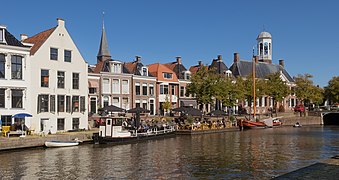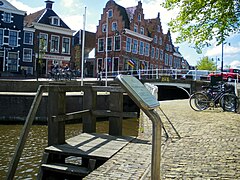Dokkum
Dokkum | |
|---|---|
City | |
 ⓘ, the city hall | |
|
UTC+2 (CEST) | |
| Postcode | 9100–9103 |
| Area code | 0519 |


Dokkum is a Dutch
History
The best-known event in Dokkum's history is the martyrdom of the Anglo-Saxon missionary
In 1923, when Catholics in the Netherlands were not allowed to engage in public expressions of faith such as processions, a processional park was built south-east of the city center, the Boniface park.[3] Central in the park is the so-called Brouwersbron, the brewers' well, which Titus Brandsma and others (incorrectly) identified as the well that sprang up after the saint's martyrdom. A chapel dedicated to Boniface was built in 1934. Brandsma, a Carmelite priest who was murdered by the Nazis in Dachau in 1942, also designed the park's Stations of the Cross, which were finished in 1949.[4]
Before 2019, the city was part of the Dongeradeel municipality.
Architecture
City hall
The city hall in Dokkum was built in 1610.
Churches
- Grote of Sint-Martinuskerk which is from the 16th century.
- Sint-Bonifatiuskerk from 1871.
- Bonifatiuskapel is from 1934
Transport
Dokkum had a station (Dokkum-Aalsum) on the
Urban development
The latest neighbourhood is called the 'Trije Terpen'. At the Trije Terpen is also the newest shopping area of Dokkum called, Zuiderschans. Other construction works in other parts of the city are also taking place, such as the Lyceumpark, the Fonteinslanden, the Veiling and the Hogedijken.
In the future the industrial park, Betterwird, will expand even more to the west. It's an industrial park with more than 70 companies. In 2013, the construction of the Central Axis began. This is a road with a fast connection and few obstacles between Dokkum and Drachten. The road was delivered in 2016.
Population
The population of Dokkum increased by 5,378 people between 1960 and 2013. In recent years, the population has fluctuated around 12,500 inhabitants.
| Year | Pop. | ±% p.a. |
|---|---|---|
| 1511 | 1,400 | — |
| 1689 | 3,177 | +0.46% |
| 1744 | 2,855 | −0.19% |
| 1795 | 2,682 | −0.12% |
| 1960 | 7,247 | +0.60% |
| 1965 | 8,440 | +3.09% |
| 1970 | 9,886 | +3.21% |
| 1975 | 10,927 | +2.02% |
| 1980 | 11,704 | +1.38% |
| 1995 | 12,510 | +0.44% |
| 2000 | 12,800 | +0.46% |
| 2010 | 12,490 | −0.24% |
| 2014 | 12,615 | +0.25% |
| 2015 | 12,583 | −0.25% |
| 2016 | 12,516 | −0.53% |
| 2017 | 12,575 | +0.47% |
| Source: Lourens & Lucassen 1997, pp. 11–12 (1511–1795), CBS Statline | ||
Sport
In the 200 km ice skating marathon known as the Elfstedentocht, Dokkum is known as the keerpunt (turning-point in Dutch), because it is where the speedskaters turn and head back to Leeuwarden. There are two different soccer clubs in Dokkum, VV Dokkum and Be Quick Dokkum.
Windmills
In 1652, Dokkum had five windmills, these were all
-
Zeldenrust
-
De Hoop
-
Zeldenrust
-
house next to mill Zeldenrust
Gallery
-
Inner harbour
-
View to a street
-
City's center around De Zijl, Dokkumer Grootdiep flowing underneath
-
Old townhouse in the city centre
-
Statue of Saint Boniface near Saint Boniface Chapel
-
Numerous footbridges in the centre
-
Wharf of the former Frisian Admiralty
-
Saint Boniface Church (1871) in the centre of Dokkum
-
Grote of Sint-Martinus Church (Dokkum)
Notable Dokkumers
Dokkum was the residence for much of her career of the pioneering midwife
- Gemma Frisius (1508-1555), scientist
- Lieuwe van Aitzema (1600-1669), prominent diplomat and historian
- Ulrik Huber (1636-1694), lawyer
- Council of State of the Netherlands
- Jan Posthuma (1963), 1996 volleyball Olympic gold medalist
- Sipke Jan Bousema (1976), TV-presenter
- Theo Pijper (1980), international speedway rider
- Saint Boniface (672-754) Exeter, Dokkum
- Dirk Rafaelsz Camphuysen (1586-1627) Gorinchem, Dokkum
- Catharina Geertruida Schrader(1656-1746) Bentheim, Dokkum
- Focko Ukena (1370 – 1435), East Frisian chieftain (hoveling), conquered Dokkum
Mayors
- Albert Jonker (1878- 1954)
- Sybren van Tuinen (1913-1993)[9]
See also
References
- ^ Aantal inwoners per woonplaats in Noardeast-Fryslân op 8 februari 2020 - Noardeast-Fryslân
- ^ Urban and village conservation areas Netherlands
- ^ Kruijtzer, Gijs (26 June 1997). "Vaderlands Toerisme". NRC Handelsblad (in Dutch).
- The Heroic Age. 6. Retrieved 20 May 2010.
- ^ Tonneel der Steden; Blaeu, 1652
- ^ "Dokkum, Friesland" (in Dutch). Nederlandse Molendatabase. Retrieved 2008-04-25.
- ^ "Dokkum, Friesland" (in Dutch). Nederlandse Molendatabase. Retrieved 2008-04-25.
- ^ "Dokkum, Friesland" (in Dutch). Nederlandse Molendatabase. Retrieved 2010-01-07.
- ^ "Drs. S. (Sybren) van Tuinen" (in Dutch). Retrieved May 14, 2019.
Literature
- Lourens, Piet; Lucassen, Jan (1997). Inwonertallen van Nederlandse steden ca. 1300–1800. Amsterdam: NEHA. ISBN 9057420082.













